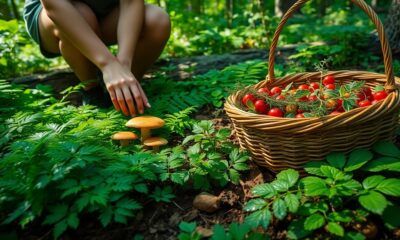Uncategorized
What Are Foraging Societies? Inside the Lifestyle That Defies Modernity!
Uncover the fascinating world of foraging societies, where ancient traditions challenge modern living—what secrets can they reveal about our connection to nature?
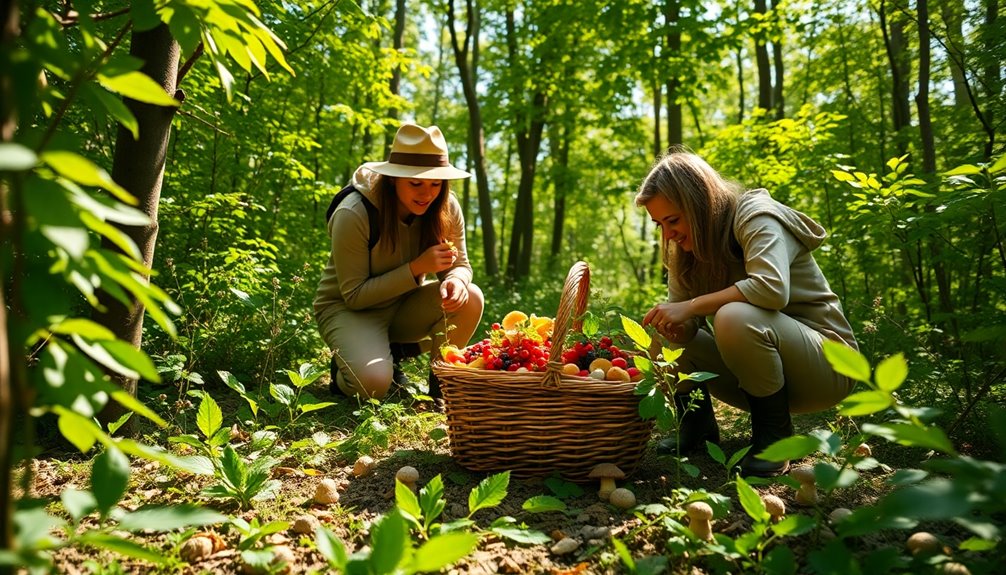
Foraging societies, often called hunter-gatherers, embody a lifestyle that thrives on the natural world. You'll find these groups relying on wild plants and game for sustenance, emphasizing community and cooperation over individual wealth. They typically live in small, egalitarian groups and spend only a few hours each day gathering food, leaving time for social activities. Gender roles play a significant part, with men hunting and women gathering, yet both contribute equally to survival. This ancient way of life offers valuable lessons today, revealing how a connection to nature can enrich your experience. Discover more about this compelling lifestyle!
Key Takeaways
- Foraging societies, or hunter-gatherers, rely on wild plants and animals for sustenance, emphasizing resource sustainability and community cooperation.
- Characterized by egalitarian social structures, they prioritize sharing, respect for elders, and cooperative child-rearing practices among small groups.
- Daily work hours are limited to 4-6, allowing ample leisure time for social activities and cultural exchanges with neighboring groups.
- These societies have existed for over 200,000 years, evolving through climate changes and adapting to their environments while maintaining traditional practices.
- Modern interest in foraging promotes sustainable practices, biodiversity, and connections to nature, encouraging ethical harvesting and appreciation for natural resources.
Definition of Foraging Societies
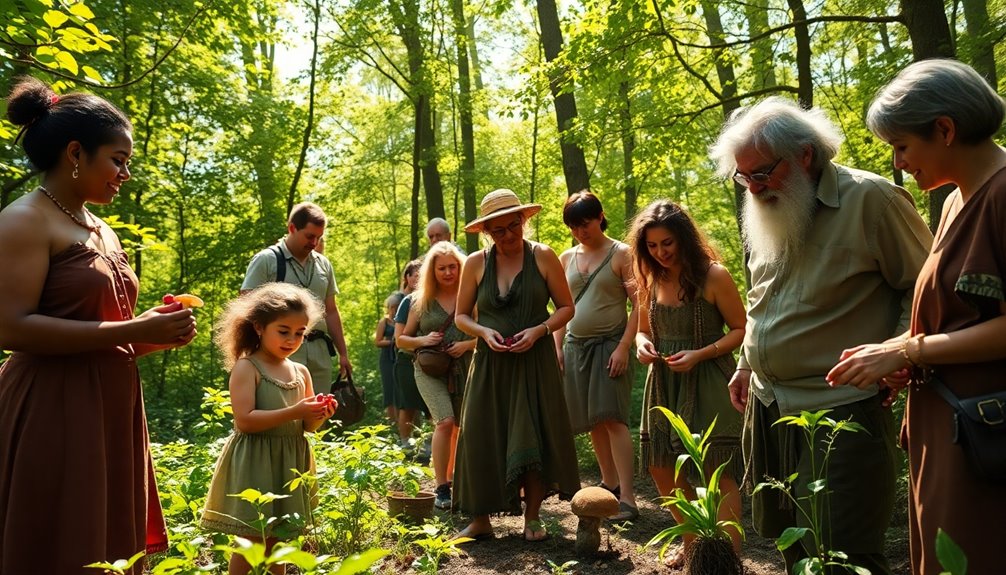
Foraging societies, often called hunter-gatherer societies, depend on wild plants and animals for food instead of farming or raising livestock. You'll find that these societies have a diverse diet, gathering fruits, nuts, roots, tubers, and berries while hunting various animals. This adaptability demonstrates their extensive ecological knowledge, enabling them to exploit multiple food sources effectively.
In foraging societies, food is consumed shortly after it's gathered or hunted, making it the only immediate return subsistence system. This means you won't see much food storage, as the focus is on immediate sustenance.
The community sizes are typically small, often ranging from 20 to 50 individuals. This creates an environment that minimizes pressure on resources and fosters social cohesion through sharing.
The social structures in foraging societies are generally egalitarian. You'll notice a cultural emphasis on sharing and cooperation, which helps to minimize wealth disparities and guarantees a more equal distribution of resources.
This way of life not only sustains individuals but also strengthens community bonds, reinforcing the importance of mutual support in their daily existence.
Historical Context and Evolution

Foraging societies have roots that stretch back over 200,000 years, long before agriculture took hold.
As climate changes shifted landscapes, some groups began experimenting with plant cultivation around 12,000 years ago, marking the shift to agricultural practices.
Understanding these origins and the impact of environmental factors can shed light on how these societies evolved over time.
Origins of Foraging Societies
Long before agriculture shaped human societies, small groups of people thrived by hunting and gathering, adapting to their environments for survival. Foraging societies have existed for around 250,000 years, relying on the natural resources around them.
These foraging groups mastered the art of tracking animals and identifying edible plants, allowing them to sustain their communities without the need for farming.
While agriculture began to emerge around 12,000 years ago, driven by climate changes and resource availability, many foraging groups continued their traditional ways.
Archaeological evidence from sites like Gobekli Tepe and Stonehenge highlights the complexity of these societies, showing that even in pre-agricultural times, they'd organized social structures and engaged in ritual practices.
Additionally, protoagricultural practices suggest that some hunter-gatherers experimented with plant domestication, hinting at an evolutionary path toward agriculture.
However, the decline of these foraging cultures began about 500 years ago, influenced by environmental shifts, colonialism, and the spread of agricultural practices.
Your understanding of these origins sheds light on the resilience and adaptability of human societies throughout history.
Transition to Agriculture
As hunter-gatherer societies flourished for thousands of years, shifts in climate and resource availability began to reshape human lifestyles. About 12,000 years ago, the change from foraging to agriculture emerged, driven by the domestication of plants and animals. This gradual shift marked a significant change in social and economic structures.
In fertile regions, particularly river valleys, early agricultural communities started to thrive. Here are some key elements of this change:
- Resource Abundance: Favorable climates and plentiful wild food sources motivated communities to settle and experiment with cultivation.
- Social Change: As agriculture took root, populations grew, leading to the establishment of permanent settlements and more complex social hierarchies.
- Cultural Diversity: While some groups embraced farming, many foraging communities continued their traditional practices, showcasing the richness of human adaptation.
The decline of hunter-gatherer cultures became pronounced around 500 years ago, as agricultural societies expanded and altered ecosystems.
This change from foraging not only transformed human existence but also laid the foundation for the modern world, illustrating the diverse paths humanity has taken in response to changing environments.
Impact of Climate Change
Climate change has dramatically shaped the trajectory of human societies, particularly in how they adapted their lifestyles over millennia. Foraging communities faced significant challenges as shifting temperatures and changing ecosystems influenced resource availability. During the last Ice Age, these groups had to modify their foraging strategies to survive in varying environments, showcasing their resilience and adaptability.
As the Ice Age came to an end around 10,000 years ago, a warming period emerged, allowing for denser populations and resource exploitation in fertile regions. This change marked the gradual shift from foraging to agricultural practices.
Evidence indicates that climate variability, including droughts and periods of abundance, directly impacted the stability and success of foraging groups, affecting their social structures and mobility.
In some areas, the pressures of climate change ultimately led to the decline of foraging societies, as diminishing resources forced these communities to adopt sedentary agricultural lifestyles.
Understanding the impact of climate change on foraging communities reveals not just their adaptability but also the profound influence environmental factors have had on human development throughout history.
Characteristics of Foraging Life
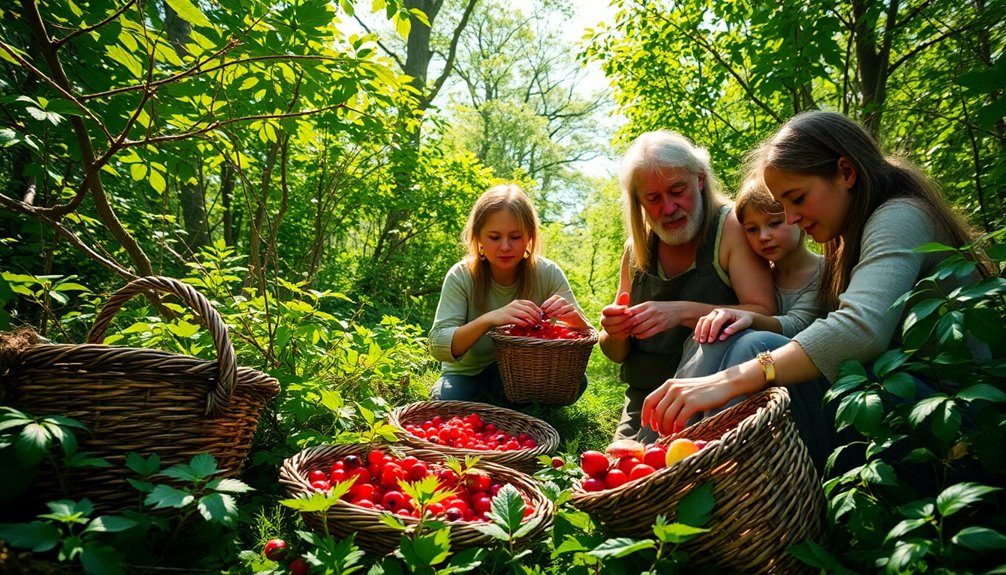
In foraging societies, you'll notice a nomadic lifestyle that drives groups to move regularly in search of food, creating a unique dynamic within their communities.
Social structure plays a significant role, with age often dictating respect and power rather than wealth or gender.
These characteristics shape not only daily life but also interactions with other groups, fostering connections and exchanges that enrich their culture.
Nomadic Lifestyle Dynamics
Foraging societies often thrive in dynamic environments, moving in small groups of 20-50 individuals to tap into seasonal food resources while evading predators. This nomadic lifestyle dynamics allows them to adapt to their surroundings effectively.
You'll find that these groups typically work only 4-6 hours a day, leaving plenty of leisure time for social interaction and physical activities.
Key characteristics of this lifestyle include:
- Childbirth Spacing: Foragers practice spacing between births to maintain manageable group sizes, ensuring sustainability in their nomadic lifestyle.
- Social Interactions: Connections with neighboring communities foster early trade networks and cultural exchanges, enriching their social dynamics.
- Respect for Elders: Age-based social divisions mean that older members are valued for their knowledge and experience, rather than wealth or gender.
Through these dynamics, foraging societies create a balanced way of life, prioritizing resource access while maintaining strong social bonds.
Social Structure and Roles
Social structures in foraging societies are often characterized by their egalitarian nature, where groups of 20-50 individuals work together closely. This small size fosters strong community bonds and resource sharing. Decisions are made collectively, minimizing wealth disparities and promoting social equality.
| Role | Description | Impact on Community |
|---|---|---|
| Men | Generally responsible for hunting | Provides protein, essential for survival |
| Women | Primarily gather plant-based foods | Contributes markedly to the diet |
| Elders | Hold higher social status due to experience | Influence resource distribution and community dynamics |
In these communities, gender roles can vary, but both men and women play vital parts in ensuring the group's survival. Elders often guide decision-making, drawing from their accumulated knowledge. Additionally, cooperative child-rearing practices strengthen social ties, ensuring that children receive care and protection from all members. This social structure allows for resilience against environmental challenges, highlighting the importance of collaboration in foraging societies.
Social Structure and Governance

How do the unique characteristics of foraging societies shape their social structure and governance? In these communities, you'll find an egalitarian social structure that minimizes wealth disparities and promotes sharing. This creates a strong sense of equality among members, which is essential for survival in resource-scarce environments.
Key aspects of their governance include:
- Elder Influence: Elders often hold higher social status, especially if they possess valuable skills in healing or rituals, guiding resource distribution.
- Cooperative Child-Rearing: This practice fosters social cohesion, allowing community members to support one another in raising children.
- Low Population Density: With typically fewer than five people per square mile, foraging societies reduce pressure on food resources, allowing for sustainable living practices.
In this setting, individuals work together to guarantee the well-being of the entire group.
While gender roles do play a part in tasks like hunting and gathering, the overall social structure emphasizes collaboration and shared responsibility.
Gender Roles in Foraging Communities
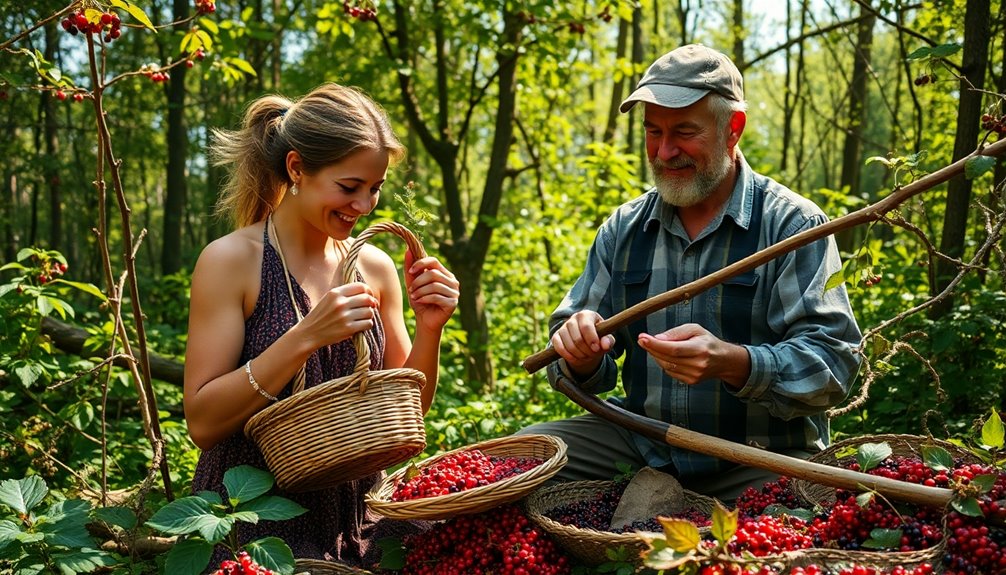
In foraging communities, you'll notice a clear division of labor based on gender, where men typically hunt large game and women gather essential plant-based foods.
This division not only shapes daily life but also influences social status, as hunting often garners more prestige despite the vital role of gathering.
Additionally, the collective effort in child-rearing reflects a shared responsibility that strengthens community ties and challenges traditional notions of hierarchy.
Division of Labor
Foraging societies often rely on a distinct division of labor based on gender, where men typically take on the role of hunting large game while women focus on gathering plant-based foods. This division of labor is essential for community survival and helps maintain a balanced diet. Notably, women can contribute up to 70% of the caloric intake through their gathering efforts.
Here are some key points about this division of labor:
- Egalitarian Social Structure: Foraging communities often minimize wealth disparities, promoting sharing and reinforcing the importance of both genders' contributions.
- Cultural Variability: Roles can vary greatly across different cultures, reflecting the adaptability of these societies to their environments.
- Elder Status: Elders, especially those knowledgeable in healing and rituals, hold higher status and influence resource distribution, further shaping social dynamics.
Understanding the division of labor in foraging societies provides insights into early human behavior and social organization. It highlights how men and women worked together to guarantee the community's survival, a dynamic that continues to inform archaeological interpretations of ancient populations.
Gender-Based Roles
Throughout history, gender roles in foraging communities have shaped the way societies functioned and thrived. In these societies, gender-based roles often dictate the division of labor, with men mainly hunting large game while women gather plant-based foods. This division can vary based on cultural context, but it's essential to recognize that women typically contribute considerably to the community's diet through gathering, often providing the majority of the food. Despite this, their contributions may not receive the same social recognition as those of male hunters.
Interestingly, gender roles in foraging societies tend to be more egalitarian compared to agricultural societies. You'll find less pronounced wealth disparities and a cultural emphasis on sharing resources, fostering a sense of community. Elders, regardless of gender, often hold a higher social status due to their knowledge and experience, influencing resource distribution.
Additionally, cooperative child-rearing practices in these communities showcase shared responsibilities across genders, enhancing social cohesion and supporting child development.
Social Status Influence
Gender roles in foraging communities greatly shape social status and influence how resources are distributed. In these societies, men often take on hunting roles, while women focus on gathering plant-based foods. However, this division can vary by culture, and the contributions of women are sometimes undervalued compared to the visible status associated with hunting.
Here are some key points about social status in foraging societies:
- Elders hold high status: Regardless of gender, elders command respect due to their accumulated knowledge and skills.
- Egalitarian principles: Foraging societies emphasize sharing and cooperation, minimizing wealth disparities and fostering community ties.
- Impact on archaeology: Understanding gender roles can help you interpret early human behavior and the importance of social structures.
These dynamics show that while gender roles influence social status, the overall structure of foraging communities promotes cooperation and resource sharing. By recognizing the value of both hunting and gathering, you can appreciate the complex interplay between gender roles and social status in these societies.
Dietary Practices and Resource Use
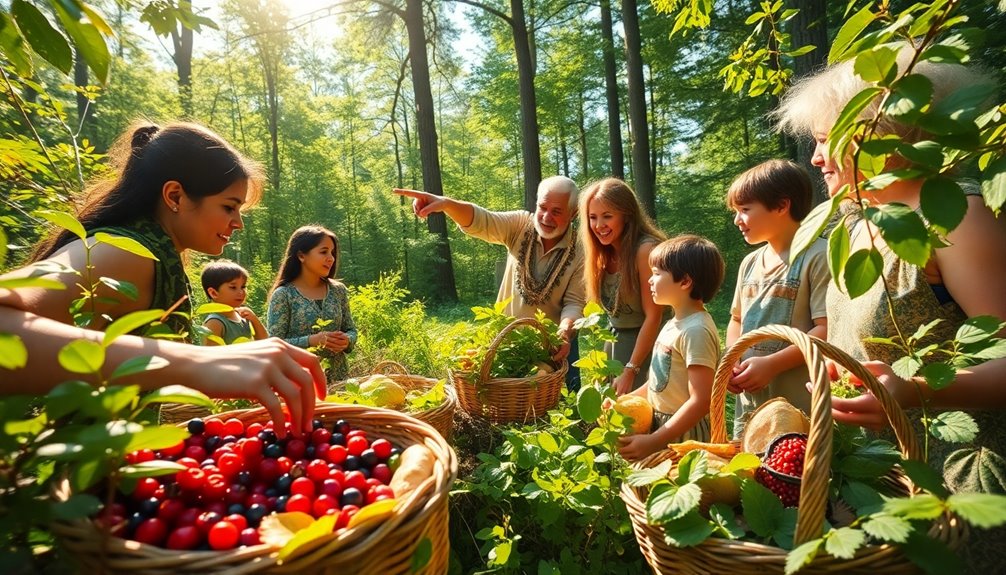
Diverse diets are a hallmark of foraging societies, where people gather a wide array of foods from their natural environment. Your dietary practices will typically include fruits, nuts, roots, tubers, and berries, supplying essential calories and nutrition.
You might also engage in hunting, which varies from targeting small game to large mammals, and fishing, where you could harvest everything from coastal shellfish to deep-sea fish.
Insects and worms, often overlooked, are significant in your diet and add to your overall caloric intake. For instance, Ach foragers are known to consume over 33 mammal species and 40 different plant species, demonstrating impressive ecological knowledge and resource utilization skills.
Resource scarcity in foraging societies shapes your social dynamics, fostering cooperation and sharing among group members. This cooperation is vital for maintaining social cohesion and ensuring the survival of the group.
Health and Life Expectancy

The health and life expectancy of foragers contrast sharply with those in modern societies, despite their varied diets and active lifestyles. While foragers typically had shorter life expectancies, averaging between 21 and 37 years, modern averages hover around 66 years.
However, the health benefits of their lifestyle shouldn't be overlooked. Foragers often enjoyed:
- Healthier diets rich in diverse foods, leading to better overall nutrition.
- Increased physical activity due to their nomadic way of life, which promoted fitness.
- Strong social interactions that fostered community bonds and emotional well-being.
Interestingly, some longevity studies suggest that certain hunter-gatherer populations might've had higher life expectancies than previously thought.
Though they faced challenges like violence and social complexities, their active lifestyle and nutritious diets contributed positively to their health.
Ultimately, while their life expectancy may seem low by modern standards, the foraging lifestyle offers valuable insights into the relationship between health, diet, and longevity.
You might find that embracing aspects of their way of life could enhance your own health and well-being.
Modern Resurgence of Foraging
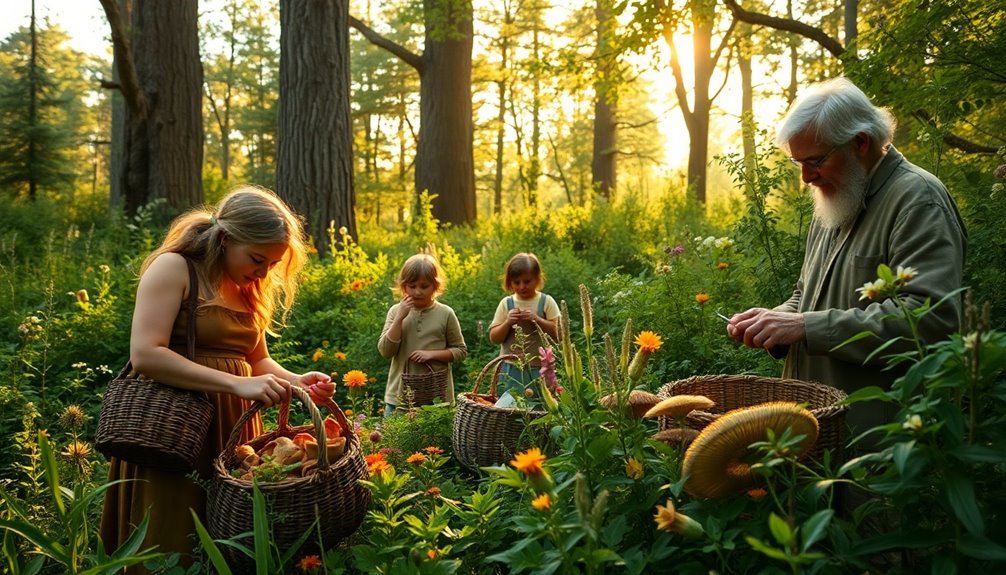
Revitalizing an ancient practice, foraging has seen a modern resurgence as people in urban areas seek to reconnect with nature and enhance self-sufficiency. You might find that engaging in foraging not only provides fresh, free food sources but also allows you to supplement your diet with seasonal and wild edibles.
As you explore local parks or even your backyard, you can discover a variety of plants and mushrooms that enrich your meals. Social media influencers have greatly contributed to this trend, sharing foraging techniques, recipes, and the many benefits of sourcing food from the wild.
This newfound interest encourages a deeper appreciation for natural resources and sustainable food practices. By embracing the modern resurgence of foraging, you're also participating in efforts to control invasive species and promote biodiversity, utilizing local ecosystems sustainably. Many foragers also benefit from understanding mushroom foraging techniques, which enhances their ability to safely identify and harvest edible varieties.
As you immerse yourself in this lifestyle, you'll likely develop a stronger connection to the environment and foster a more environmentally conscious approach to living. The modern resurgence of foraging isn't just about food; it's a movement toward a healthier, more self-reliant way of life, deeply rooted in nature.
Safety and Ethical Considerations

Foraging can be an exciting adventure, but it's crucial to prioritize safety and ethics while you explore. You need to be aware of the potential risks, especially when it comes to plant identification. Consuming the wrong plant can lead to serious health issues, so always confirm what you're foraging.
Here are some tips to keep you safe and ethical:
- Start with small portions of foraged foods to test for allergies and adverse reactions.
- Consult local guides or experts who can teach you about edible species and safe foraging techniques.
- Practice sustainable foraging by leaving some plants behind to encourage growth and maintain biodiversity. Additionally, consider using multi-functional gear to enhance your foraging experience and ensure you have the right tools on hand.
Archaeological Insights and Discoveries
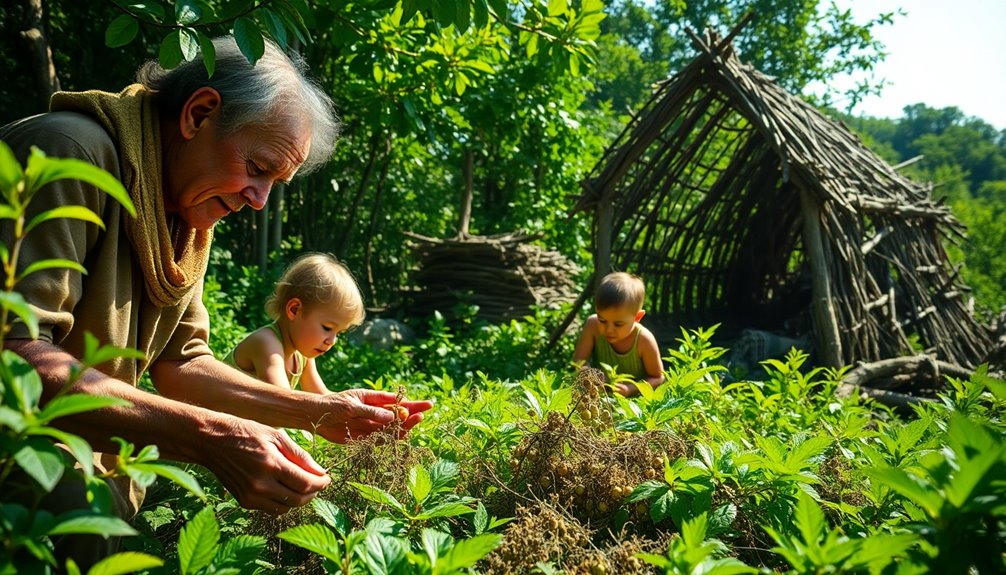
Archaeological discoveries offer fascinating insights into the lives of foraging societies, revealing their intricate social structures and rich cultural practices. Key sites like Gobekli Tepe and the Altamira cave paintings showcase the complex societal organization and artistic expression of these groups.
You'll find that excavations have uncovered evidence of foragers utilizing a diverse range of resources, with over 33 mammal species and 40 plant species consumed by groups like the Ach foragers.
Additionally, studies of sites like Stonehenge highlight the ritualistic and communal aspects of foraging communities, illustrating their social interactions and cultural practices. These archaeological insights indicate that foraging societies maintained trade networks and cultural exchanges with neighboring groups, greatly contributing to early social structures.
Moreover, the analysis of ancient tools and artifacts from these sites enhances our understanding of technological advancements and resource utilization in prehistoric human societies.
Frequently Asked Questions
What Are Foraging Societies?
Foraging societies are groups that rely on hunting and gathering for survival.
You'll notice they typically consist of small, mobile communities, often moving seasonally to find food. Their diets can be quite diverse, including fruits, nuts, and various animal species.
In these societies, social structures tend to be egalitarian, with men hunting and women gathering.
Despite the modern world, these groups showcase resilience and adaptability in utilizing natural resources for sustenance.
Do Foraging Societies Exist Today?
Yes, foraging societies do exist today.
You'll find groups like the San people and the Inuit still practicing traditional hunting and gathering. Even in urban areas, many individuals embrace modern foraging, seeking wild foods and natural ingredients.
This lifestyle emphasizes sustainability and environmental stewardship, showcasing a deep connection to nature.
However, these communities face challenges from land rights issues and industrial encroachment, threatening their traditional ways of life.
What Is Forage in Sociology?
In sociology, foraging refers to the practice of obtaining food by hunting, gathering, and fishing rather than through agriculture or livestock.
You rely on wild resources, utilizing your knowledge of the environment to find edible plants and animals. Foragers often work in groups, sharing their finds to promote cooperation and social bonds.
This lifestyle emphasizes sustainability and adaptation, allowing you to thrive within your ecosystem while maintaining a deep connection to nature.
What Is the Foraging Way of Life?
The foraging way of life involves hunting and gathering food directly from nature. You rely on your knowledge of local plants and animal behavior to find diverse resources like fruits, nuts, and game.
This lifestyle requires mobility, as you move to follow seasonal food availability. You'll often work collaboratively within small groups, sharing resources and responsibilities.
Gender roles might divide tasks, but both men and women play essential roles in ensuring the group's survival.
Conclusion
In exploring foraging societies, you glimpse a world where harmony with nature reigns, a melody of survival that dances through the ages. These communities, rooted in simplicity, teach us the art of living with purpose and connection. As modernity rushes by like a fleeting breeze, you can find inspiration in their wisdom, reminding you that beneath the chaos, there's beauty in the basics—a call to rediscover the rhythms of life and nurture the earth that sustains us.
Uncategorized
What Caused Some Humans to Shift From Foraging to Farming? Scientists Reveal All!
On the brink of transformation, early humans faced climate shifts and resource scarcity—what drove them to abandon foraging for farming? Discover the surprising answers!

You'll find that the shift from foraging to farming stemmed from a mix of climate changes and the need for stable food sources. After the Ice Age, fertile areas like the Fertile Crescent emerged, attracting early humans. Resource scarcity from overhunting pushed communities to explore agriculture, initially growing wild grains. As people settled, agricultural innovations allowed for surplus food and trade, transforming social structures. Yet, this new lifestyle brought health risks and sparked resistance, as many still valued the foraging way of life. To uncover more layers of this fascinating evolution, keep exploring the details behind this monumental change.
Key Takeaways
- Climate change post-Ice Age made formerly inhospitable regions fertile, prompting the search for stable food sources.
- Resource scarcity from overhunting increased the demand for reliable food supplies, leading to agricultural practices.
- The Fertile Crescent's rich soil provided ideal conditions for early farming, supporting population growth and agriculture's rise.
- Early innovations in plant and animal domestication enhanced food security, enabling settled communities and trade networks.
- Social hierarchies emerged as land ownership developed, influencing wealth distribution and labor specialization in farming societies.
Historical Context of Foraging
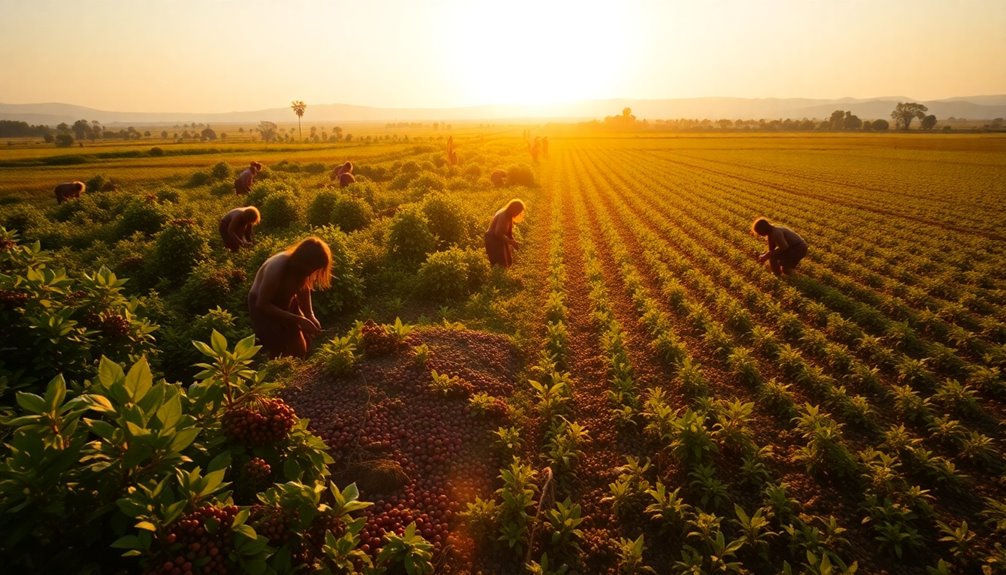
For over 100,000 years, humanity's survival hinged on foraging and hunting, shaping our ancestors' way of life. During this extensive period, humans relied on gathering wild plants and hunting animals, creating a diverse diet that supported their nomadic existence.
Initial foraging practices were rich and varied, allowing for the consumption of numerous food sources, which helped sustain small, mobile communities.
As the Neolithic era approached, around 12,000 years ago, a significant shift to agriculture began. Early farming methods emerged alongside the exploitation of wild grains, which had been gathered and consumed for thousands of years. This change marked a pivotal moment in human history, as foraging practices gradually diminished in favor of more settled agricultural lifestyles.
While foraging provided a wealth of nutrients, it also required constant movement in search of resources. As populations grew, so did the pressure on these wild plants, leading to a gradual adaptation to farming.
The complex social structures and cultural practices developed by foragers laid the groundwork for future societies, setting the stage for the profound changes that agriculture would bring.
Environmental Factors Influencing Change
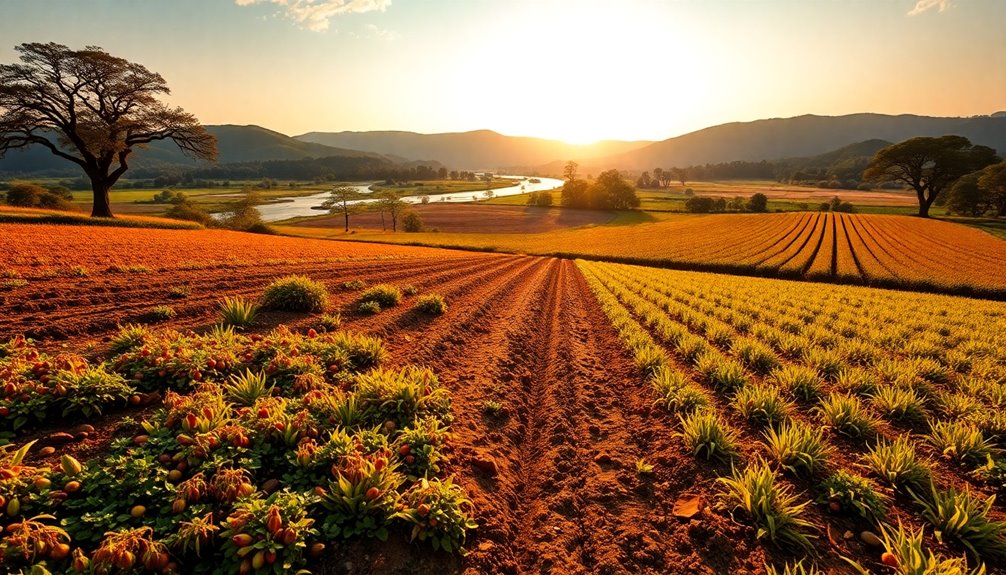
As climate change transformed the landscape after the Ice Age, regions once deemed unsuitable for farming became fertile and inviting. This shift created opportunities for early humans to explore new ways of securing food. Resource scarcity, driven by overhunting and environmental changes, pushed communities to seek more stable food sources. This necessity led to a significant change from foraging to farming.
Several key environmental factors influenced this shift:
- Fertile Crescent: This region offered ideal conditions for agriculture, with rich soil and a favorable climate that encouraged the growth of various crops.
- Population Growth: As communities expanded, the demand for a reliable food supply increased, prompting a move toward agricultural practices to sustain larger populations.
- Agricultural Innovations: In response to environmental pressures, humans developed techniques like the domestication of plants and animals, which enhanced food security and improved resource management.
Together, these factors created a compelling case for early humans to embrace farming, marking a pivotal shift in human history. This change laid the groundwork for modern civilization as we understand it today.
Initial Agricultural Practices
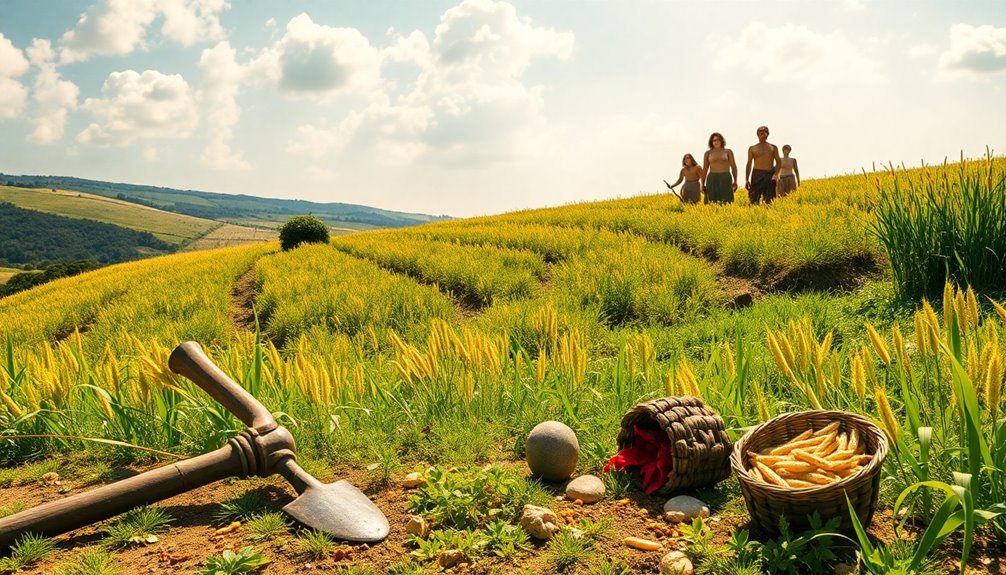
The shift from foraging to farming kicked off with early humans gathering and planting wild grains, setting the stage for a transformative agricultural revolution. These initial agricultural practices marked a significant change in human lifestyle, as societies began to rely on domesticated crops like wheat and barley. This reliable food source allowed communities to settle and grow, laying the foundation for modern civilization.
Early farming techniques utilized simple tools and methods, such as hand planting and harvesting. While less productive than later advancements, these methods were essential in establishing the groundwork for agriculture. Additionally, the creation of irrigation systems enhanced water availability, particularly in arid regions, supporting crop growth.
Here's a breakdown of some early agricultural practices:
| Early Agricultural Practices | Description |
|---|---|
| Gathering | Collecting wild grains and seeds |
| Planting | Sowing seeds in prepared soil |
| Hand Harvesting | Manually collecting mature crops |
| Irrigation | Directing water to crops |
| Settled Communities | Establishing permanent living spaces |
This gradual shift to farming unfolded over generations, showcasing humanity's adaptability to new agricultural methods.
Social and Economic Impacts
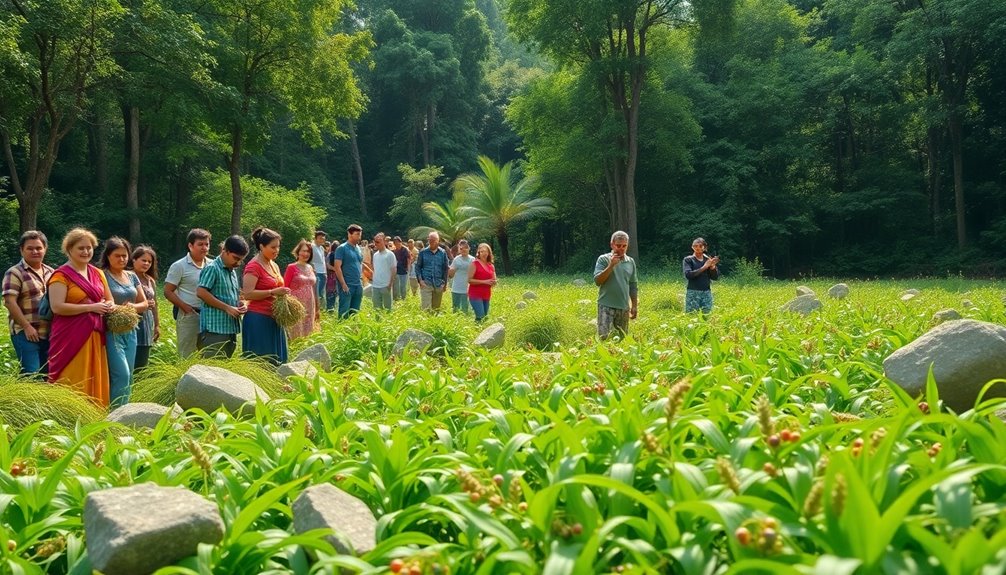
A significant shift from foraging to farming transformed social and economic structures in early human communities.
You'd notice that surplus food production allowed for trade, leading to the emergence of market networks. This newfound abundance didn't just fill bellies; it reshaped how people interacted.
- Social Hierarchies: As agricultural practices flourished, land ownership became a key factor in wealth accumulation. This created distinct social hierarchies as some individuals controlled more resources than others. Furthermore, the rise of agriculture led to a decrease in mobile lifestyles, as people began to settle in one place. This shift contributed to increased emotional volatility within communities, as interpersonal relationships became more intense and complex. Additionally, this increase in population density often necessitated the development of renewable energy sources to support growing communities.
- Permanent Settlements: Farming supported the establishment of permanent settlements, which in turn facilitated larger populations. This increased density fostered more complex social dynamics and governance structures.
- Labor Specialization: With surplus food, people could pursue various professions beyond agriculture. Labor specialization emerged, enhancing economic complexity and innovation within communities.
Additionally, these changes allowed for the development of complex social dynamics, leading to richer cultural exchanges and societal growth.
Resistance to Farming Adoption
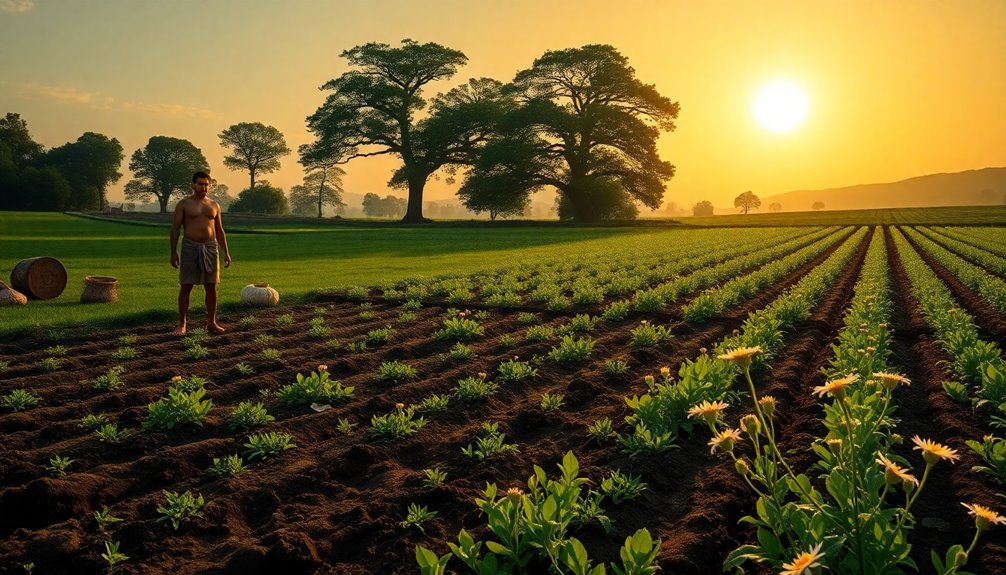
You might find that many communities resisted farming due to health concerns linked to early agricultural practices.
The fear of poor nutrition and weakened bones made foraging seem like a safer option.
Additionally, a strong cultural connection to traditional foraging may have further fueled this reluctance to switch to farming.
Health Concerns
Health concerns played a significant role in the resistance to farming adoption among early human populations. Many foragers perceived their lifestyle as not only sufficient but also healthier compared to the emerging farming practices. The shift to agriculture brought about notable health issues, leading many to hesitate in making the switch.
- Reduced Dietary Diversity: Farming often resulted in reliance on a few domesticated crops, leading to malnutrition and vulnerability to food shortages. Foragers enjoyed a varied diet that supported better overall nutrition.
- Increased Disease Transmission: Dense populations in farming communities made it easier for diseases to spread. Living closely together facilitated the transmission of pathogens, making people wary of adopting such lifestyles.
- Health Problems: Evidence from skeletal remains indicates that the introduction of farming correlated with a decline in health, including osteoarthritis and dental issues. The stability provided by agriculture came with significant health trade-offs.
These factors contributed to a cautious approach toward farming, as many early humans valued their foraging lifestyle, which seemed to better support their health and nutrition needs. Furthermore, the historical context of emotional dysregulation in response to these changes may have influenced societal attitudes toward adopting new agricultural practices.
Cultural Attachment to Foraging
Historically, many Northern European hunter-gatherer groups often clung to their foraging traditions, viewing them as a reliable source of sustenance. This cultural attachment to traditional foraging practices created a strong reluctance to embrace the change to farming.
You can imagine how deeply rooted these lifestyles were; established social structures and knowledge systems revolved around hunting and gathering techniques that had been passed down through generations.
For many, the perception that foraging provided sufficient food reduced their motivation to change. After all, early agricultural methods often led to negative health outcomes, such as poor nutrition and unhealthy bones.
Why would you want to adopt a system that could jeopardize your well-being? The shift to farming represented not just a change in diet, but a significant behavioral shift that increased labor and introduced dietary limitations.
Moreover, the immediate benefits of agriculture weren't always apparent. When you weigh the proven success of foraging strategies against the uncertainties of farming, it's clear why some groups resisted this new lifestyle.
The comfort of tradition held strong, making it challenging to abandon a way of life that had long served them well.
Archaeological Insights and Discoveries
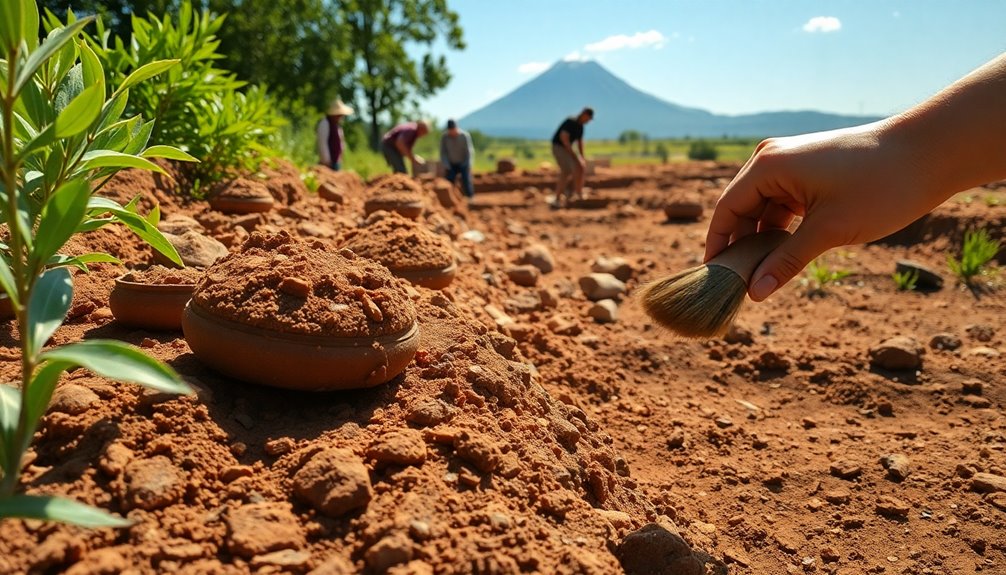
As recent archaeological discoveries reveal, the shift from foraging to farming wasn't a sudden event but a gradual change marked by significant social and cultural developments. Excavations in the Azraq Basin of Jordan uncovered long-term hunter-gatherer settlements, challenging the notion that these groups were merely transient.
You'll find that these findings highlight several key aspects of early human history:
- Sedentary Lifestyles: Sites like Kharaneh IV, occupied for 1,200 years, revealed stone tools and oval hut structures, suggesting that hunter-gatherers would establish more permanent communities.
- Cultural Sophistication: Analysis of over 1,400 skeletons showed sophisticated burial practices, including emotional ties to animals through joint burials, indicating a complex social structure.
- Gradual Agricultural Practices: Discoveries of wild grain exploitation, dating back 14,500 years, suggest that the behavioral shifts leading to farming communities were more gradual, possibly starting as early as 19,000 years ago.
These archaeological insights paint a detailed picture of how hunter-gatherers engaged with wild plants and animals, setting the stage for the eventual rise of farming in human history. Additionally, the development of community engagement in agricultural practices can be observed as societies began to form around shared resources and farming techniques.
Future Research Directions
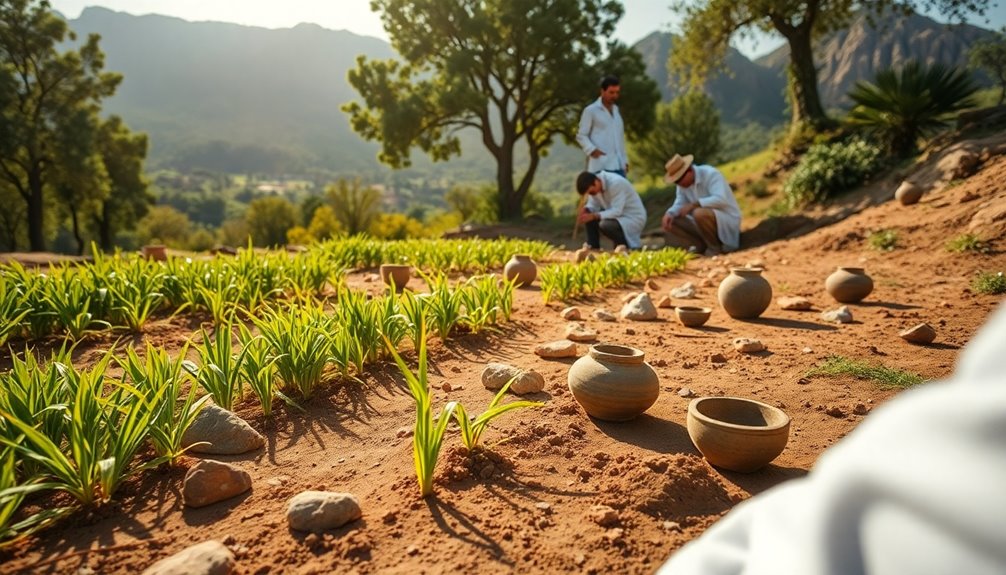
Recent archaeological findings illuminate the complexity of early human societies, paving the way for future research directions that promise to deepen our understanding of the change from foraging to farming. One key area of focus is uncovering earlier agricultural practices, which suggest humans may have cultivated plants as far back as 19,000 years ago. This timeline challenges previous beliefs and invites a reevaluation of how early communities adapted to farming.
Future research will also explore the behavioral complexities associated with this gradual change from foraging. Investigating the environmental factors, including climate change and resource scarcity, will be essential to understanding how these elements influenced early human societies.
Additionally, researchers plan to examine the social structures of farming communities, looking at property rights and group dynamics that facilitated the adoption of agriculture.
Moreover, the integration of mathematical models in archaeological studies will enhance our comprehension of the dynamics of early agricultural societies. These models will help simulate group sizes, conservatism, and the spread of agricultural innovations, providing insights that will shape our understanding of this transformative period in human history.
Frequently Asked Questions
What Caused Humans to Shift From Foraging to Farming?
You might wonder what caused humans to shift from foraging to farming. This change occurred as populations grew and resources became scarce.
Warmer climates after the Ice Age made new areas suitable for agriculture. You'd notice that by domesticating plants and animals, communities could rely on consistent food sources.
This shift led to permanent settlements and the development of social structures, fundamentally changing how humans lived and interacted with their environment.
Why Did the Transition From Foraging to Farming Occurred in the Nile Valley?
Picture a lush oasis where the Nile flows like a lifeline. You see fertile soil and predictable floods, beckoning you to cultivate crops.
Around 10,000 years ago, you find that growing emmer wheat and barley offers a stable food supply, unlike the uncertainty of hunting. As the climate warms and irrigation techniques emerge, your community flourishes, leading to organized societies and trade.
This vibrant transformation from foraging to farming reshapes your world forever.
Why Did We Shift From Food Foraging to Food Production?
You shifted from food foraging to food production mainly to secure a reliable food supply.
As populations grew, you faced challenges like resource scarcity. Warmer climates made farming viable, allowing you to cultivate crops and domesticate animals.
This change provided a more stable diet, despite early farming's lower productivity and nutritional drawbacks.
Why Did People Stop Foraging?
When the rubber hit the road, people started to realize that relying on foraging wasn't cutting it anymore.
Scarcity of resources due to overhunting and environmental changes left you craving a more stable food supply.
With rising populations and a warmer climate, you found fertile land that made farming a viable option.
Innovations like seed planting and animal domestication offered you dependable food, transforming your lifestyle and paving the way for settled communities.
Conclusion
As you reflect on humanity's journey from foraging to farming, it's clear this shift was fueled by a blend of environmental changes and social dynamics. Like a seed planted in fertile soil, these early innovations blossomed into complex societies. Understanding this transformation not only reveals our past but also reminds us of our resilience and adaptability. Embrace the lessons of history, as they still guide us in steering through the challenges of today's world.
Uncategorized
How Tall Do Forage Oats Get? Farmers Can’t Believe the Growth!
Incredible heights of forage oats can astonish farmers; discover the secrets behind their growth and how to achieve optimal yields.
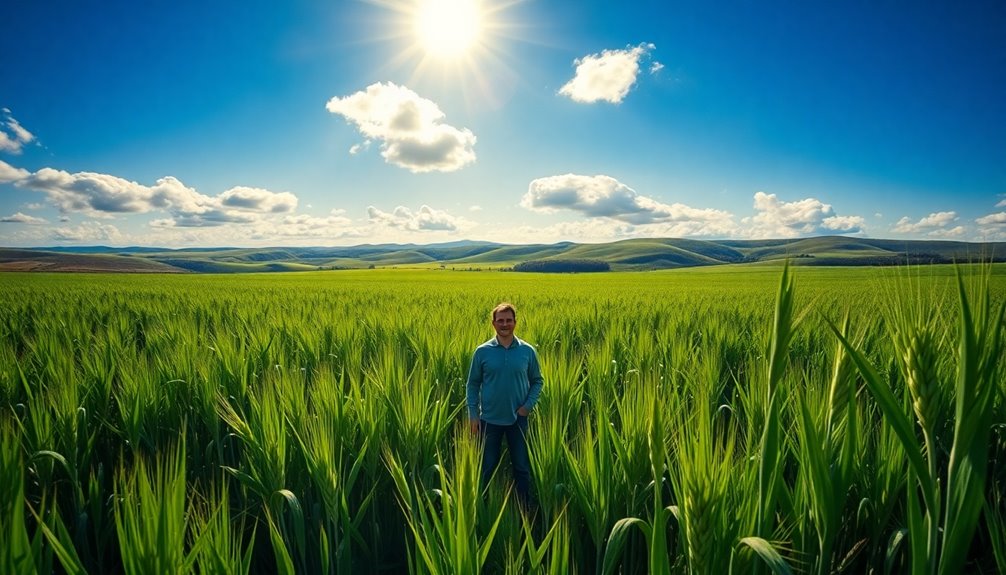
Forage oats can reach impressive heights between 2 to 4 feet, which often surprises farmers. Their growth largely depends on factors like soil quality, moisture, and variety. For instance, winter oats tend to grow taller than spring oats due to better tillering. To optimize height, make certain you've got nutrient-rich, well-drained soil and consider factors like planting density and nitrogen levels. Maintaining the ideal growth height is essential for quality forage. If you want to uncover more about maximizing your oat yield and other effective strategies, there's plenty more to explore.
Key Takeaways
- Forage oats typically grow between 2 to 4 feet tall, depending on the variety and growing conditions.
- Winter oats generally reach greater heights than spring oats, which may only grow 1.5 to 3 feet.
- Growth height is influenced by factors like soil quality, moisture, temperature, and planting density.
- Early maturity allows for multiple cropping cycles, maximizing overall height and yield potential.
- Proper management practices, like nitrogen fertilization and mowing, can enhance oat height and forage quality.
Overview of Forage Oats
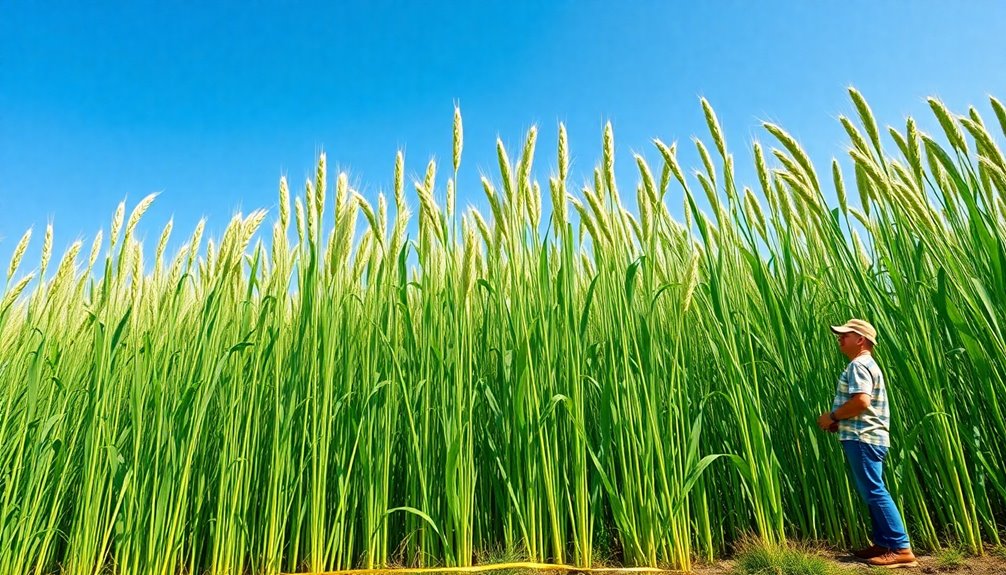
Forage oats are an excellent choice for livestock feed, thanks to their impressive growth and nutritional benefits. These oats are specifically bred to reach heights of 2 to 4 feet, depending on the variety and growing conditions. Their growth patterns allow for early maturity, giving you the chance to achieve multiple cropping cycles in a single growing season. This is especially advantageous for maximizing your feed resources.
With a rich nutritional profile, forage oats offer high digestibility and palatability, making them particularly appealing to livestock like cattle and sheep. This guarantees your animals receive the nutrients they need for peak health and productivity.
Moreover, forage oats can be intercropped with legumes, which enhances nitrogen fixation and greatly improves soil health. Their extensive root systems also contribute to better soil structure and moisture retention, promoting overall agricultural sustainability. Additionally, incorporating forage oats into your crop rotation can further optimize feed efficiency, ensuring a sustainable and productive farming strategy.
Factors Influencing Oat Height
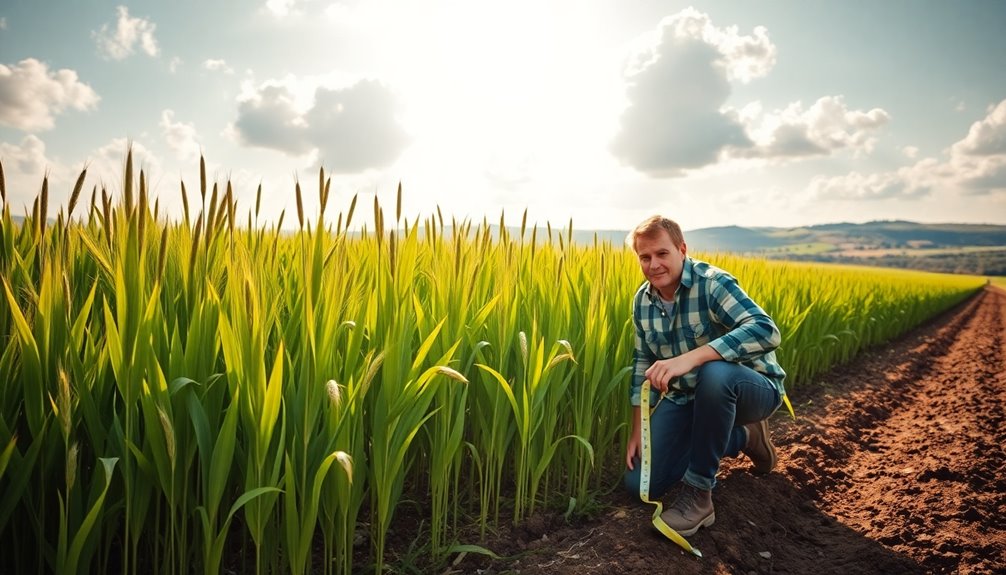
Height in forage oats is influenced by several vital factors that can noticeably affect their growth potential. One of the most important is soil quality. Nutrient-rich, well-drained soil greatly enhances growth, allowing your oats to reach impressive heights. Conversely, poor soil can stunt their development.
Weather factors also play an important role. Adequate moisture from rainfall and ideal temperatures contribute to increased height and overall plant vigor. Without the right climate conditions, your oats may struggle to thrive.
Planting density is another significant factor. When you plant oats too closely, they compete for resources, which can lead to reduced growth. It's important to find the right spacing to guarantee your plants have enough room to flourish.
Finally, fertilization practices, particularly nitrogen application, can promote taller growth. However, be cautious; excessive nitrogen might cause lodging, which can compromise plant quality and stability.
Common Varieties and Their Heights
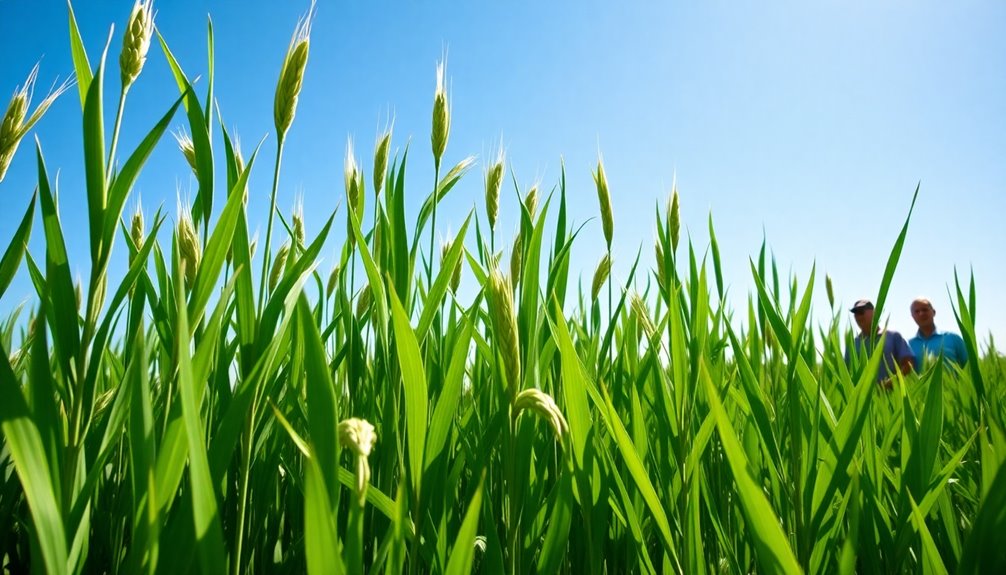
When selecting the right varieties of oats for forage, it's important to contemplate how different types can affect growth and yield. Common forage oat varieties, like Avena sativa, are specifically bred for livestock feed. These varieties often exhibit vigorous growth, reaching heights of 2 to 4 feet under ideal growth conditions.
Winter oats, in particular, stand out due to their better winter hardiness and can grow taller than spring oats. While winter oats thrive, spring oats may struggle to tiller effectively, typically reaching only 1.5 to 3 feet in height.
If you're aiming for dense stands that attract deer, choosing the right oat varieties is essential. To maximize growth and yield, confirm you're planting in well-drained, nutrient-rich soils and adhering to proper soil conditions.
Additionally, monitor height measurements throughout key growth stages. Ideally, maintain your forage oats around 3-4 inches for ideal deer attraction before they reach maturity. This approach not only enhances the height of your crop but also boosts its overall productivity, making it a win-win situation for your forage needs.
Ideal Growing Conditions
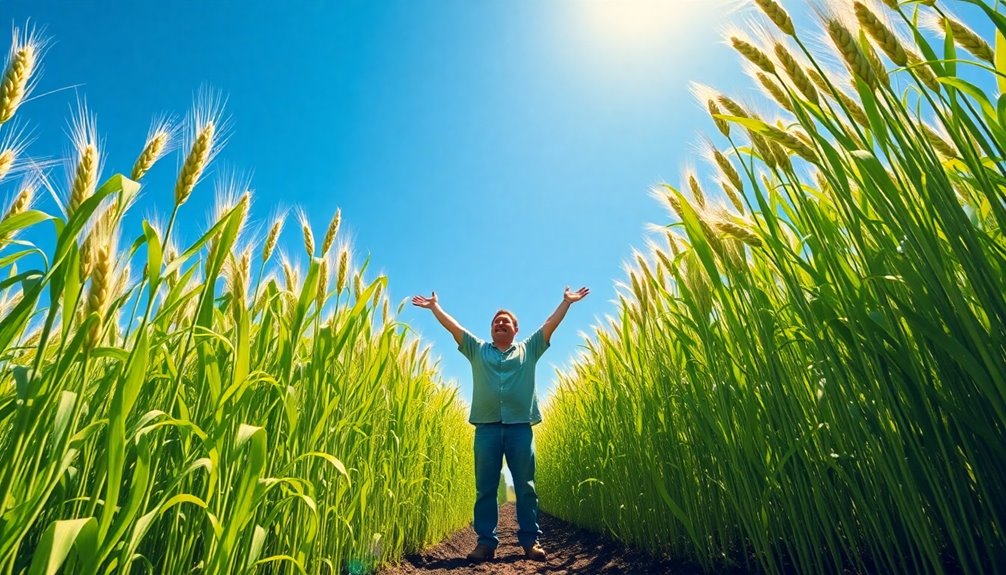
To achieve ideal growth for your oats, it's essential to focus on the right environmental conditions. The height and yield of your forage oats will greatly depend on several factors that promote their development.
- Choose the right oat variety for your region.
- Verify you have nutrient-rich soil with a pH around 7.0.
- Monitor for regular rainfall to keep the soil moist.
- Aim for moderate temperatures to support growth.
- Fertilize adequately, especially with nitrogen, to boost plant height.
Forage oats thrive in prime growing conditions, which include well-drained, nutrient-rich soil. They flourish in cool, moist climates, making regular rainfall vital.
Early planting, ideally in late August to early September, helps your oats establish strong roots before frost. This timing enhances their growth, making them more attractive to deer and other wildlife. Additionally, insulation upgrades can improve overall crop resilience by maintaining soil temperature.
Impact of Soil Quality
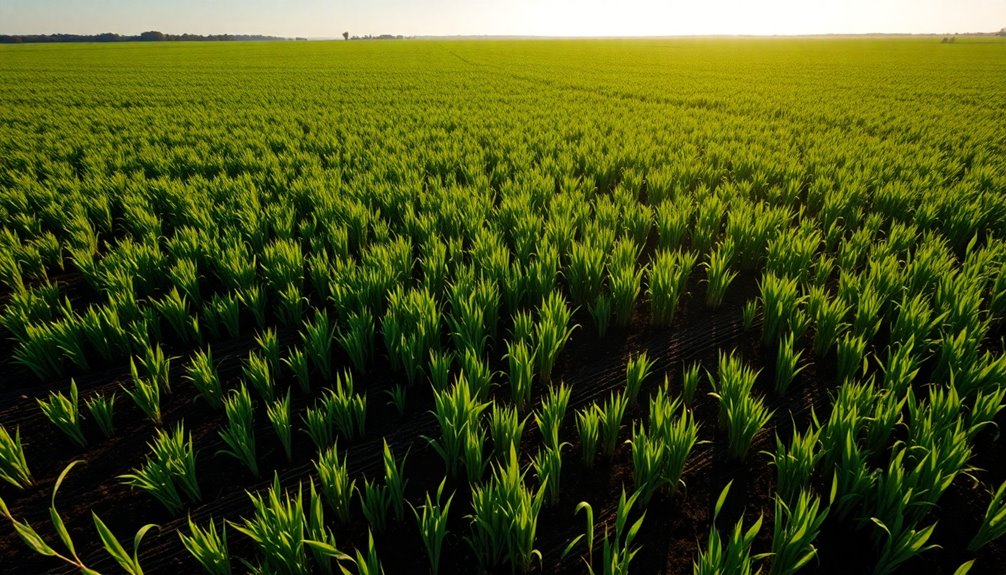
The quality of your soil plays a vital role in the success of your forage oats. When you start with nutrient-rich, well-drained soil, you set the stage for ideal plant height and yield potential. High organic matter content in your soil contributes to better root development, which enhances moisture retention and promotes overall growth.
To achieve the best results, aim for a soil pH around 6.0 to 7.0. This range promotes nutrient availability, which is essential for maximizing both the height and palatability of your forage oats. If your soil suffers from compaction or low fertility, you'll likely see stunted growth and shorter, less productive plants.
Regular soil testing is key to understanding your soil quality. By testing, you can identify deficiencies and make necessary amendments. Adding lime can help adjust pH, while balanced fertilizers supply the essential nutrients your forage oats need to thrive.
With the right soil quality, you're not just growing oats; you're cultivating success in your farming endeavors. So, invest in your soil, and watch your forage oats reach impressive heights!
Deer Preferences and Feeding Behavior
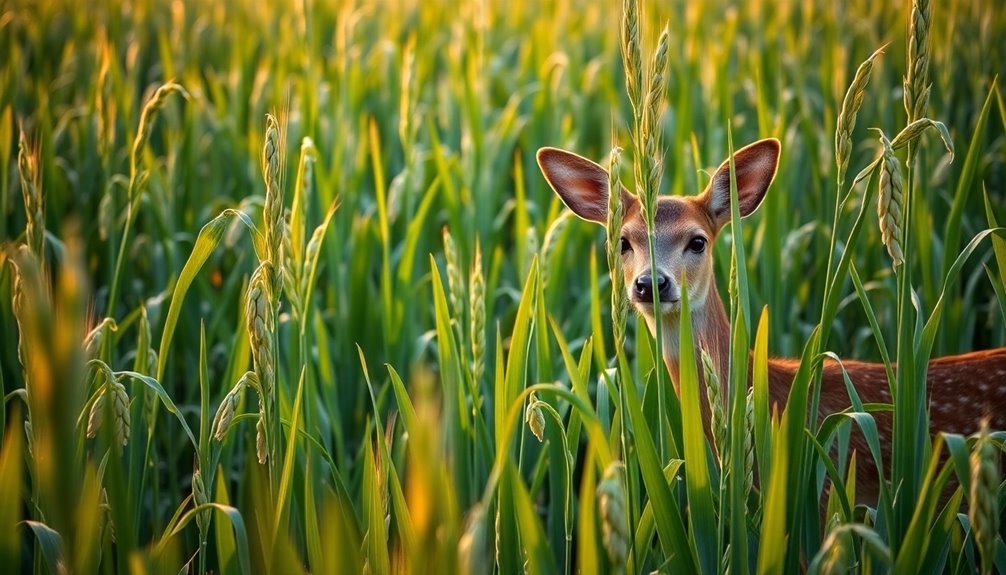
When planting forage oats, you should consider deer preferences for ideal growth.
They tend to favor oats at about 3-4 inches tall, as taller plants lose their appeal.
Plus, understanding seasonal foraging patterns can help you create food plots that attract deer when their nutritional needs peak.
Optimal Plant Height
At around 3-4 inches, forage oats present the most enticing option for deer, as they prefer these young, tender shoots over taller, more mature plants. If you want to attract deer effectively, keeping your forage oats at this ideal height is vital. Here's why:
- Increased palatability: Young shoots are more flavorful for deer.
- Enhanced feeding behavior: Deer are more likely to visit when oats are at their ideal height.
- Reduced competition: Taller plants lose appeal, leading to decreased deer attraction.
- Promotes new growth: Mowing before oats reach excessive heights boosts fresh shoots.
- Higher visitation rates: Monitoring and maintaining the right height keeps deer coming back.
Once oats grow beyond 8-10 inches, they start to lose their attractiveness. Mature plants often develop grain heads, further decreasing their palatability.
Consequently, it's important to monitor the height of your forage oats consistently. By doing so, you can guarantee that you're providing the best feeding conditions for deer, ultimately enhancing their presence on your land.
Keep those oats at the right height, and watch your deer population thrive!
Seasonal Foraging Patterns
Monitoring the height of your forage oats isn't just about keeping them attractive; it also influences deer foraging patterns throughout the seasons. Deer will eat the young, tender growth stages of forage oats, with ideal heights around 3-4 inches.
As the seasons shift, food availability changes, leading to increased deer visits to your food plots during late summer and fall. Here, forage oats are at their most nutritious, drawing deer in for a hearty meal. Pet therapy can also be beneficial to caregivers managing deer populations, as it helps reduce stress and improve focus during demanding tasks.
After the first frost, the sweetness of your oats enhances their appeal, prompting deer to forage more aggressively. This behavior continues into winter, as deer seek out established oat fields, even digging through snow if necessary.
The high nutritional value of fall-planted forage oats makes them a top choice for deer, who show a marked preference for these over spring-planted varieties. Additionally, understanding sustainable harvesting practices can help ensure that forage oats remain a reliable food source for deer season after season.
Nutritional Preferences of Deer
Deer have distinct nutritional preferences that greatly influence their feeding behavior. One of their favorites is young, tender forage oats. These juvenile growth stages are highly palatable and digestible, making them irresistible to deer.
When you're managing your food plots, keep this in mind:
- Deer really love young, tender forage oats.
- Palatability decreases when oats grow taller than 3-4 inches.
- Seasonal food availability, like acorns and clover, affects their foraging habits.
- Post-frost, oats become sweeter and more attractive to deer.
- Monitor deer activity closely, especially in winter months.
As the forage oats mature, deer tend to avoid them, shifting their focus to other food sources.
During late summer and fall, you'll notice deer foraging more aggressively in well-established food plots, particularly when oats are young and tender.
If you want to attract deer to your property, prioritize cultivating these young oats, especially after frost. They'll be drawn to the sweet, nutritious food, helping you create a thriving environment for deer.
Effective Planting Strategies
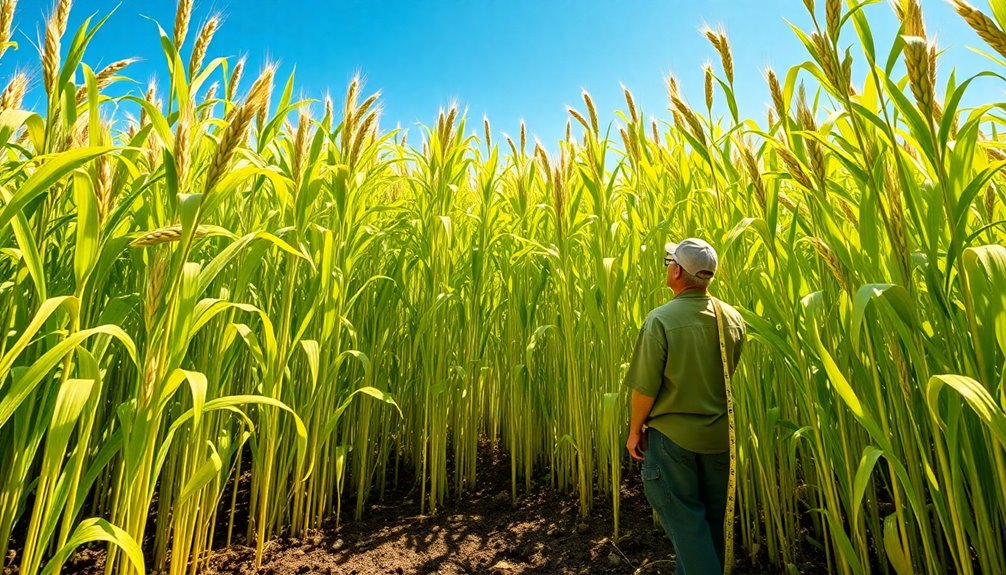
When it comes to effective planting strategies for forage oats, timing and preparation are essential for success. Aim to plant your oats in late August to early September, with the first week of September being the ideal window. This timing allows for better establishment and attracts deer more effectively.
Before you plant your oats, don't forget to apply soil amendments like lime and fertilizer. These enhancements create nutrient-rich soil, improving forage quality and making your plot irresistible to deer.
Consider using a standard 80-pound bag of feed oats, which can cover nearly an acre, making it a cost-effective choice at around $12 per acre.
After planting, keep an eye on deer feeding patterns, especially post-frost. The fresh oat grass becomes markedly more appealing and nutritious after frost exposure, so adjusting future planting strategies based on this observation can lead to even better results.
Managing Height for Optimal Forage

To achieve ideal forage, managing the height of your oats is essential. Forage oats can grow between 2 to 4 feet, but keeping them at an ideal height enhances both palatability and deer attraction.
Here are key strategies to take into account:
- Maintain early growth at 3-4 inches for tender shoots.
- Mow when oats exceed desired heights to promote new growth.
- Monitor soil quality, moisture, and temperature for ideal growth.
- Avoid excessive height to reduce lodging risks. Best outdoor survival bags are designed to help adventurers carry essential gear efficiently.
- Timing your management can maximize nutrient availability. Additionally, consider incorporating essential oils into your farming practices for potential pest control benefits. Moreover, maintaining optimal forage height can ensure efficient heating for livestock by providing them with adequate nutrition and comfort.
Economic Benefits of Forage Oats

When considering forage oats, you'll find they're a cost-effective crop choice that can boost your profitability.
With rising market demand for high-quality forage and its nutritional benefits for livestock, growing forage oats makes more sense than ever.
Cost-Effective Crop Choice
Forage oats present an economically advantageous crop choice for farmers looking to maximize productivity and profitability.
While the initial seed cost may be higher—around $15 more per 48-pound bag compared to traditional oats—the benefits far outweigh this expense. You can expect forage oats to yield 3-5 times more tillers, greatly boosting your overall output.
Here are some compelling reasons to evaluate forage oats:
- Higher yield potential increases productivity.
- Selling prices for oat hay range from $6 to $7 per bale.
- Lower input costs lead to better profit margins.
- Reduced winter feed expenses enhance profitability.
- Access to niche markets for high-quality forage.
Increasing Market Demand
As demand for high-quality forage continues to rise, farmers are finding that forage oats offer not just a viable crop option but also significant economic benefits.
With the average market price for forage oats climbing to between $6 and $7 per bale, the financial incentive is clear. These oats typically yield more than traditional varieties, with reports of 100-120 bales per acre for winter varieties, enhancing your profit margins even further.
The increasing market demand for gluten-free products has also boosted the value of oats, carving out a profitable niche for those focusing on forage oats.
Lower input costs associated with growing forage oats compared to other grains mean you can maximize returns while minimizing expenses. This not only makes forage oats an attractive option for livestock feed but also strengthens their economic appeal.
As the market for high-quality forage continues to grow, forage oats stand out as a smart investment. Diversification strategy in crop selection can further enhance financial stability.
They can effectively reduce your feed costs during the winter months, ensuring that you stay ahead of the competition while reaping the rewards of your hard work.
Nutritional Livestock Benefits
A significant advantage of incorporating forage oats into your livestock feeding strategy is their exceptional nutritional profile.
Forage oats aren't only rich in fiber and protein but also improve the digestibility of feed, which boosts livestock growth rates and overall health. This enhanced digestibility leads to better feed conversion efficiency, making forage oats an invaluable resource. Research indicates improved engagement in STEM subjects can be paralleled in livestock management practices that utilize innovative feeding strategies. Additionally, the use of herbal alternatives has been shown to improve the health of livestock, further enhancing their performance. Furthermore, the incorporation of forage oats can lead to higher yields in livestock production due to their nutrient-rich composition.
Consider these benefits:
- High fiber content supports digestive health.
- Excellent protein source for cattle and sheep.
- Increased energy levels for improved performance.
- Economic savings on winter feed costs.
- High yield potential, reaching 100-120 bales per acre.
Additionally, these oats can serve as a source of nutritional livestock benefits, promoting overall well-being and productivity in the herd.
Frequently Asked Questions
How Tall Do Forage Oats Get?
Forage oats typically grow between 2 to 4 feet tall, depending on the variety and growing conditions.
You'll notice that winter oats often reach greater heights due to their hardiness. In the early stages, they can hit 3-4 inches, which deer find most appealing.
However, factors like soil quality, moisture, and planting density can affect their height. Proper management is key, as excessive growth can lead to reduced palatability and lodging issues.
How Tall Will Oats Get?
When you're growing oats, you might notice they can reach heights of 2 to 4 feet, depending on the variety and conditions.
If you're aiming for deer attraction, keep them around 3-4 inches during the juvenile stage. Taller oats may lose palatability, so it's essential to monitor their growth.
Factors like soil fertility, moisture, and temperature will also influence how tall your oats ultimately get, so stay attentive to those conditions.
What Are the Highest Yielding Forage Oats?
If you're looking for high-yielding forage oats, consider varieties like 'Haybuster' and 'BFO'.
These can produce up to 100-120 bales per acre when you manage them properly.
Depending on your soil quality and weather conditions, you might see average yields ranging from 60 to 140 bushels per acre.
How Tall Should Oats Be Before Grazing?
You know that feeling when you spot a perfect patch of oats? Before you graze, make sure they're about 3 to 4 inches tall.
At this height, they're tender and palatable, attracting more deer and maximizing their nutritional value. If they grow taller than 8 to 10 inches, their taste diminishes, and the animals won't be as interested.
Conclusion
In the world of farming, forage oats can be your secret weapon, towering like giants in a lush green field. By understanding their growth factors and ideal conditions, you'll not only boost your yields but also attract hungry deer, turning your land into a thriving ecosystem. Embrace the potential of forage oats, and watch as your hard work pays off, transforming your farm into a verdant paradise reminiscent of the Garden of Eden. Don't miss out on this opportunity!
Uncategorized
How Much Forage Does a Cow Eat? The Number That’ll Blow Your Mind!
Surprising facts about cow forage intake will leave you amazed—discover the numbers that can transform your herd’s health and productivity!
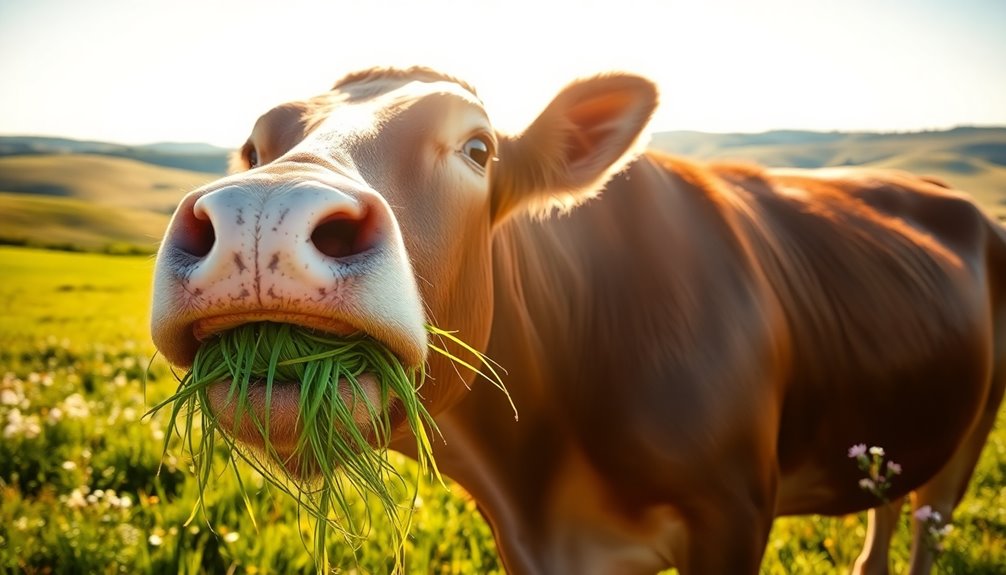
Cows can eat an eye-popping 2.5% to 2.7% of their body weight in forage daily, especially if they're lactating and on high-quality pastures. For a 1,200-pound cow, that means consuming around 30 pounds or more of forage each day! Factors like the cow's size, the forage quality, and whether they're pregnant or lactating all impact their intake. Higher-quality forage lets cows consume more, boosting their health and productivity. Want to uncover more fascinating facts about cow nutrition and feeding practices? There's plenty more to explore about how to optimize your herd's forage intake!
Key Takeaways
- A lactating cow weighing 1,200 lbs can consume up to 36 lbs of quality forage daily.
- Dry matter intake (DMI) typically ranges from 1.8% to 2.7% of a cow's body weight.
- High-quality forage (≥8% crude protein) allows for greater intake compared to low-quality forage (<6% crude protein).
- Seasonal changes can significantly impact daily forage consumption and availability.
- Larger cows require more forage, directly correlating their size with consumption levels.
Understanding Dry Matter Intake
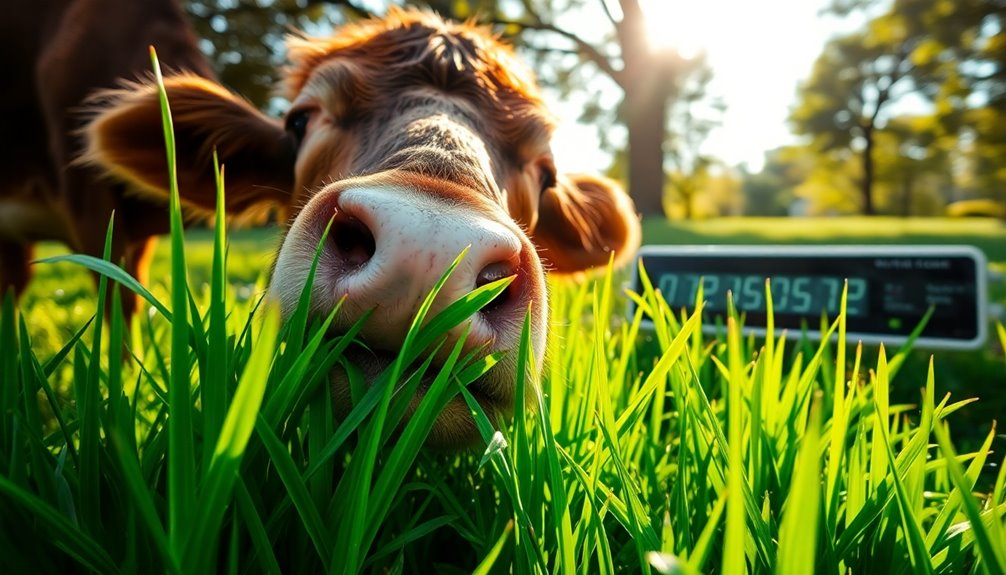
When it comes to managing your cattle's nutrition, understanding dry matter intake (DMI) is key. DMI refers to the amount of feed consumed after excluding moisture content, which is essential for accurate nutritional assessments.
For instance, a 1,200 lb cow that eats 24 lb of hay at 88% dry matter actually consumes about 27 lb on an as-fed basis due to moisture.
Factors like forage quality, cow weight, and lactation status greatly impact daily DMI. Lactating cows generally consume more than non-lactating cows to meet their nutrient needs, often reaching 2.5%-2.7% of their body weight when eating high-quality forages like corn silage.
Monitoring DMI helps you manage forage inventory effectively, particularly during periods of scarcity like calving, ensuring you minimize hay wastage and optimize feeding strategies.
Factors Influencing Forage Consumption
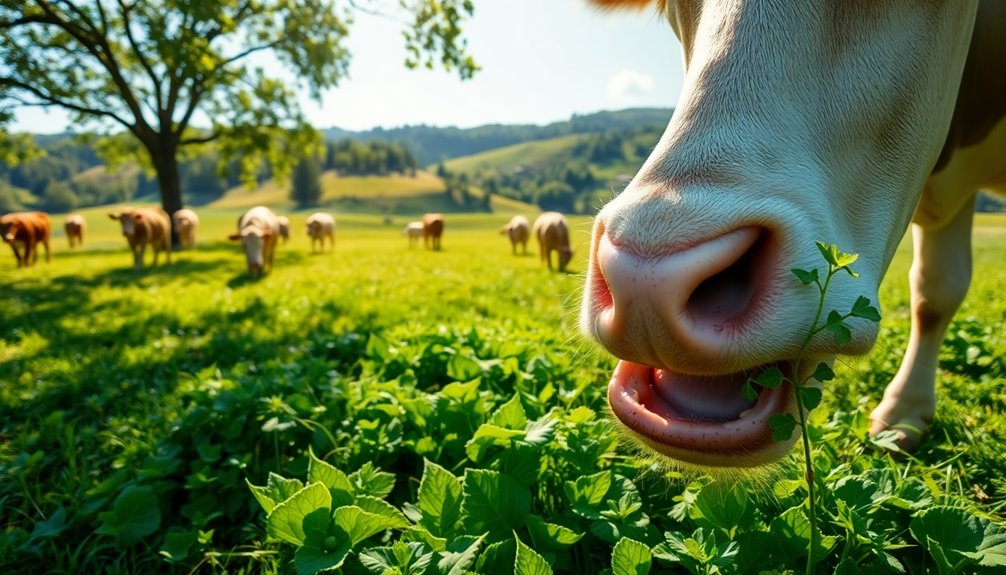
Forage consumption in cows is influenced by several critical factors, including forage quality, cow condition, and environmental conditions. Understanding these influences can help you enhance your cows' forage intake and overall health.
- Forage Quality: High-quality forage can increase daily intake considerably.
- Body Weight: A cow's size impacts its overall consumption; larger cows eat more.
- Nutrient Content: The Total Digestible Nutrients (TDN) in forage determines how much energy and nutrients a cow receives.
- Seasonal Variations: Changes in pasture availability can affect feeding needs.
For instance, a 1,200 lb lactating cow can consume about 28 lb of high-quality forage daily, especially when it contains around 55% TDN. In contrast, if you're feeding low-quality forages (≤52% TDN), expect a consumption rate of about 1.8% of body weight for non-lactating cows.
Additionally, lactating cows require about 50% more TDN than dry cows, demanding increased forage intake during their lactation period. By factoring in these elements, you can guarantee your cows receive ideal nutrition to maximize their productivity and health.
Quality of Forage Matters
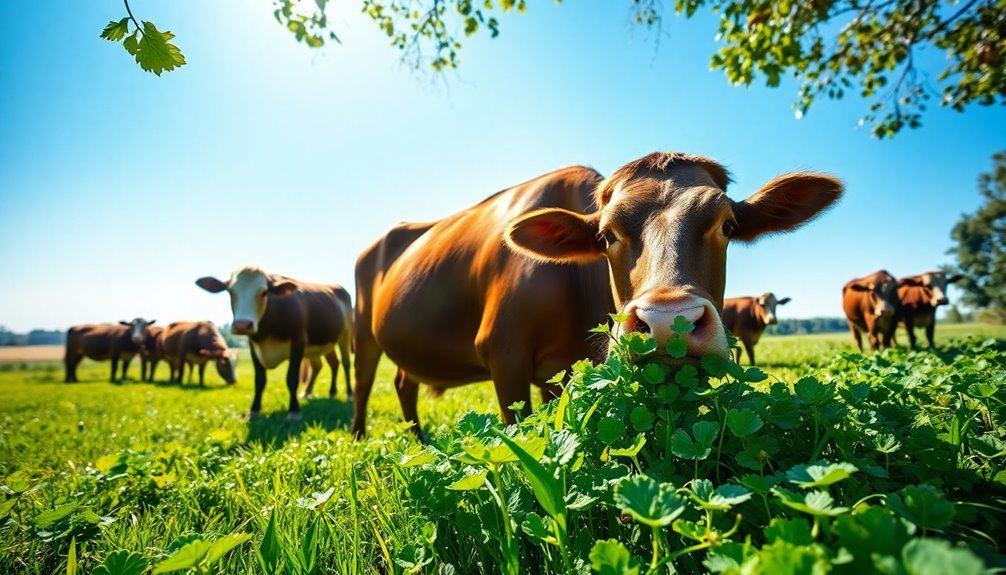
Quality of forage plays an essential role in determining how much cattle consume and their overall health. It's fascinating how the nutrient content can impact a cow's intake. For instance, when you provide low-quality forage with less than 6% crude protein, your cow may only consume around 1.5% of its body weight daily. In contrast, higher-quality forage containing at least 8% crude protein allows for approximately 2% body weight intake.
Here's a quick look at how different forage qualities can affect intake:
| Forage Quality | Crude Protein (%) | Daily Intake (Pounds) |
|---|---|---|
| Low Quality | < 6% | ~18 lbs (1.5% BW) |
| Good Quality | 8% | ~24 lbs (2% BW) |
| Excellent Quality | ≥ 8% | ~30 lbs (2.5% BW) |
| High Digestibility | 55% TDN | ~28 lbs (Lactating) |
| Mature Forage | Varies | Reduced Intake |
The digestibility of these forages is significant. Better digestibility means your cow can absorb more nutrients, leading to improved health and productivity. Prioritizing quality forage is essential for maximizing your cow's potential.
Estimating Daily Feed Requirements
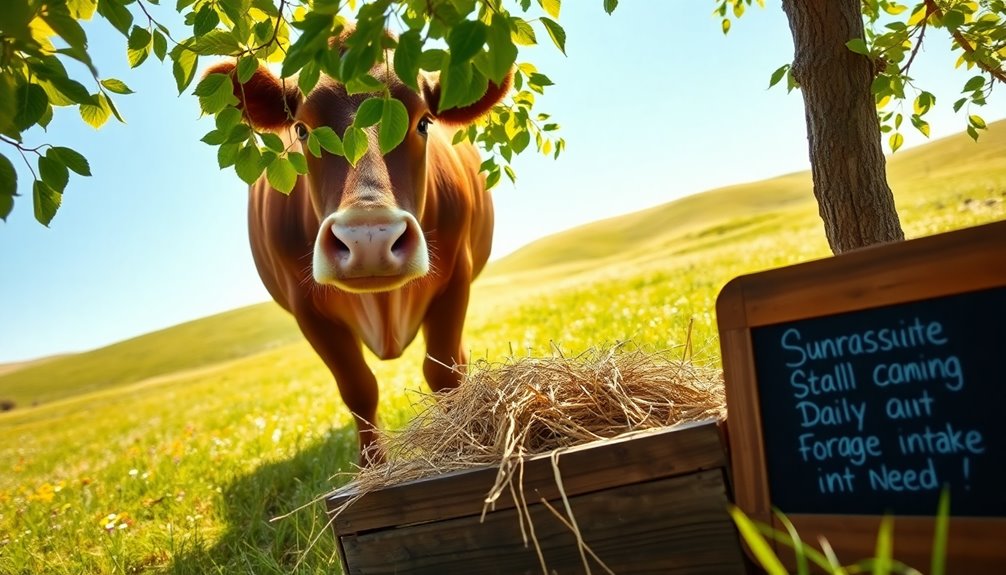
Understanding how much feed your cows need is essential for maintaining their health and productivity, especially after exploring how forage quality impacts their intake. When estimating daily feed requirements, you must consider factors like body weight, moisture content, and nutrient needs.
- A 1,200 lb pregnant cow typically consumes about 24 lbs of good-quality grass hay daily, factoring in a 15% hay wastage rate, which brings it to around 30 lbs.
- Lactating cows need more, consuming up to 36 lbs of as-fed hay daily to meet their heightened energy and nutrient needs.
- Dry matter intake for non-lactating cows is about 1.8% to 2.1% of their body weight, while lactating cows can reach 2.5% to 2.7%.
- Accurate estimates of daily feed intake help manage your forage inventory, especially during scarce periods.
Seasonal Feeding Strategies
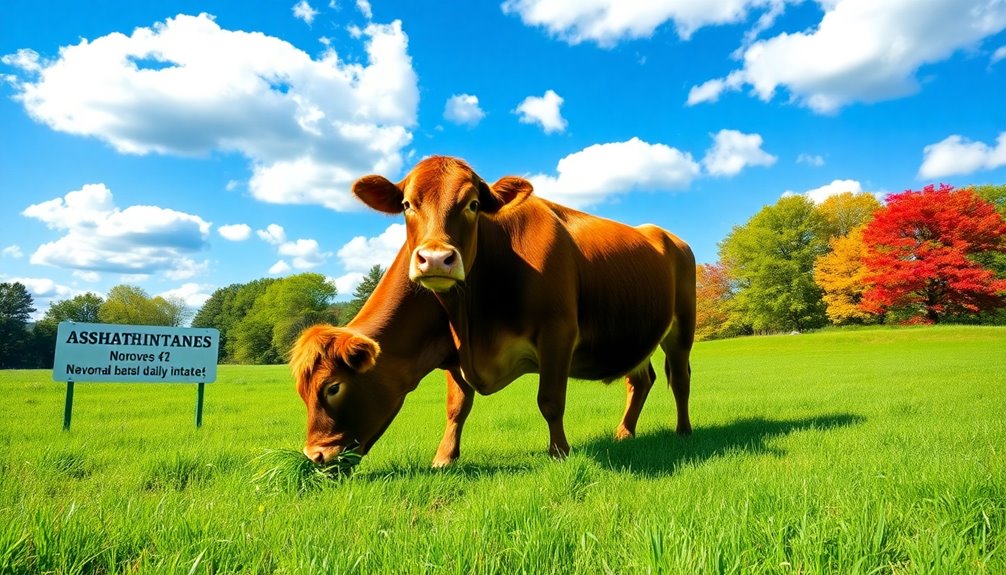
Adapting your feeding strategies throughout the seasons is vital for maintaining ideal cow health and productivity. Seasonal variations in forage availability can drastically affect your hay feeding needs, especially during fall and winter months when standing forage may be limited.
In the fall, utilizing native and Bermudagrass pastures can help reduce reliance on hay, allowing you to make the most of your available forage resources.
As winter sets in, you'll likely find pastures covered in snow or ice, making hay feeding more necessary. This is when it's important to accurately estimate your cows' daily intake needs to guarantee they receive the nutrition they require.
Keeping historical records of forage availability can assist you in predicting how long you'll need to feed hay and plan for any potential shortages.
Moreover, implementing supplementation programs during times of lower-quality forage can greatly enhance digestion and nutrient absorption, further supporting cow health and productivity.
Frequently Asked Questions
How Much Forage Does a Cow Eat per Day?
When you consider how much forage a cow eats daily, it really varies based on several factors.
A typical 1,200 lb pregnant cow usually consumes around 24 lbs of good-quality hay, but that can increase if the cow is lactating or if the forage quality is exceptional.
Generally, you can expect a non-lactating cow to eat about 2.0% of its body weight in good-quality forage, adjusting for moisture and wastage.
What Is the Mental Capacity of a Cow?
Cows have a remarkable mental capacity, comparable to that of a human toddler.
You'll find that they can solve problems and remember experiences for years. They recognize faces, both of other cows and humans, showcasing their strong memory.
Plus, they can learn by observing others, which helps them adapt.
Cows also experience emotions like joy and stress, affecting their well-being, and they communicate through vocalizations and body language to convey their feelings.
How Much Hay Will a 1200 Pound Cow Eat?
Imagine your 1,200-pound cow as a voracious bookworm, devouring pages of hay daily.
She'll munch through about 24 pounds of good-quality hay, about 2% of her body weight.
But wait! If the hay's moisture content is considered, that number jumps to around 26 pounds.
Factor in some wastage, and you'll need to provide about 30 pounds daily to keep her satisfied and healthy.
Adjust her intake as her needs change, especially after calving!
How Much Does a 1000 Lb Cow Eat a Day?
A 1,000 lb cow typically eats about 20 to 24 lbs of dry matter each day, which is roughly 2.0% to 2.4% of its body weight.
If you're feeding hay, that translates to around 25 to 28 lbs on an as-fed basis, depending on moisture content.
Keep in mind that quality matters; high-quality forages can increase intake to about 25 lbs or more.
Be sure to account for hay wastage, too!
Conclusion
To sum up, understanding how much forage a cow eats can really change your perspective on cattle management. Did you know that a single cow can consume up to 2.5% of its body weight in dry matter daily? That's around 30-40 pounds for an average cow! By considering factors like forage quality and seasonal variations, you can optimize your feeding strategies. Keeping these insights in mind can lead to healthier cattle and better yields for your farm.
-

 Foraging Basics2 months ago
Foraging Basics2 months agoAdd a Forage Certificate to Your LinkedIn Profile and Level Up Your Career
-

 Edible Wild Plants2 months ago
Edible Wild Plants2 months agoUnbelievable Power: The World's Most Formidable Forage Harvester
-

 Foraging Basics1 month ago
Foraging Basics1 month agoForage the City: Your Guide to Successful Urban Foraging
-

 Foraging Basics2 months ago
Foraging Basics2 months agoThe Shocking Truth About Foraging (That Experts Don’t Want You to Find Out)
-

 Foraging Basics1 month ago
Foraging Basics1 month agoThe Resume Hack That Will Make Your Foraging Experience Stand Out
-

 Recipes and Preparation2 months ago
Recipes and Preparation2 months agoThe #1 Sought-After Forage That's Transforming Livestock Nutrition
-

 Recipes and Preparation2 months ago
Recipes and Preparation2 months agoThe One Wild Edible That Will Transform Your Cooking (And It’s Free!)
-

 Foraging Basics2 months ago
Foraging Basics2 months agoDiscover the Largest Forage Wagon in the World!


